[ad_1]
The Curiosity rover is slowly making its way up Mount Sharp, a 3-mile-tall mountain on Mars. Mountains are useful to study as their steep slopes can reveal layers of material laid down over time, like a geological time capsule. But just like heaving up a mountain is a challenge for humans, it can be tricky for rovers too. Curiosity recently took on a particularly steep and slippery slope, marking its most challenging climb to date.
How difficult terrain is for a rover to pass depends on a number of factors, including how steep it is, how slippery the sand is, and what obstacles such as boulders or sharp rocks are present. This ascent, which the rover tackled through May and June, had all of the above including a 23-degree incline. “If you’ve ever tried running up a sand dune on a beach – and that’s essentially what we were doing – you know it’s hard, but there were boulders in there as well,” said Amy Hale, a Curiosity rover driver at NASA’s Jet Propulsion Laboratory (JPL), in a statement.

The rover drivers like Hale plan out the safest possible route for the rover to travel to get it where it needs to go, then send these commands on to the rover. That’s necessary because of the communications delay between Earth and Mars, which can be up to 20 minutes depending on the planets’ relative positions to each other, which would make it impossible to drive the rover in real time. It also allows for more careful forward planning to ensure no harm comes to the rover.
However, sometimes the rover has issues following the commands sent by the drivers, such as if a wheel slips or rolls across a high rock. If the rover experiences any unexpected circumstances like these, it is programmed to stop to prevent any damage — and the drivers refer to these stops as faults.
In the recent ascent, these faults were a frequent issue. “We were basically playing fault bingo,” said Dane Schoelen, Curiosity’s strategic route planning lead at JPL. “Each day when we came in, we’d find out we faulted for one reason or another.”
The drivers decided to take a slight detour which added a few weeks of travel but turned out to be easier to traverse and allowed the rover to reach the end of the climb.
“It felt great to finally get over the ridge and see that amazing vista,” Schoelen said. “I get to look at images of Mars all day long, so I really get a sense of the landscape. I often feel like I’m standing right there next to Curiosity, looking back at how far it has climbed.”
Editors’ Recommendations
[ad_2]









